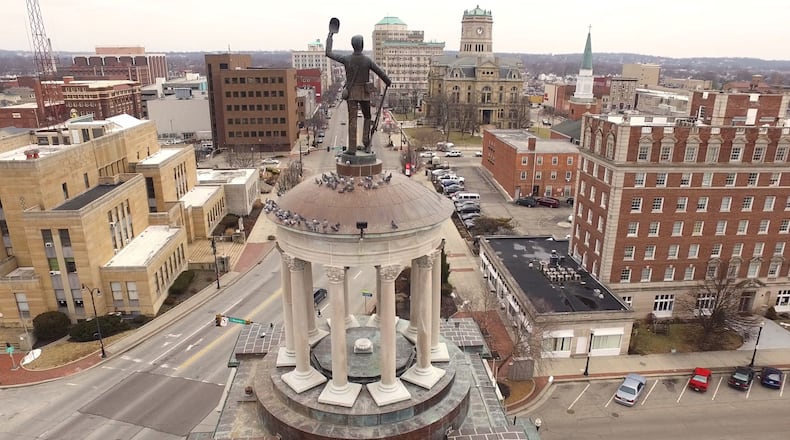Ceremonies for the laying of the monument’s cornerstone were conducted Nov. 27, 1902 and the building’s shell was completed in October 1904. The memorial was dedicated on July 4, 1906 as a permanent memorial to Butler County war veterans and pioneers. The building was designed by architect Fred Noonan and was built for a total cost of $71,266.73, including the bronze statue on top of the monument.
For nine years, the care and maintenance of the memorial was the responsibility of the City of Hamilton. However, in 1915 the Ohio General Assembly enacted House Bill 398 which amended the original 1898 enabling law and transferred ownership of the monument to Butler County. The amendment also empowered the county to employ a janitor, “one of the qualifications of whom shall be that he is an honorably discharged soldier or sailor from the United States army or navy who shall have sole care and control of said monument and the site of the same and who shall be vested with all the ordinary powers of a policeman” (Section 9, HB 398, April 30, 1915).
Early custodians were Civil War veterans. The first custodian of record was Jacob Jackson (1841-1934), a member of the Hamilton Fire Department for more than 35 years who was known to have great pride in his work at maintaining the “Old Neptune” engine. He served at the memorial from 1906 to 1923. George Washington Dilyerd (1843-1936), a carpenter by trade, replaced Jackson and acted as custodian for thirteen years until his death in 1936. Shortly after the Butler County Historical Society was formed in 1934, the society gave honorary life memberships to Jackson, Dilyerd and the other five surviving members of the Grand Army of the Republic.
An April 25, 1936 a “Journal-News” article reported that the Butler County Commission had selected Walter Scott McDonald to replace Dilyerd as the monument’s new custodian. McDonald (1878-1949) had served as the Lance-Corporal of Company C of the 28th Regiment of the U.S. Volunteer Infantry during the Spanish-American War. He enlisted Aug. 23, 1899, received training at Camp Meade, Pennsylvania, and sailed from the Presidio in San Francisco on Oct. 25, arriving in Manila Bay, Philippines on Nov. 23, 1899.
His company fought in battles at Putol, Perez Das Marinas, Sinishian River, Taal and several other skirmishes. McDonald and his company returned to San Francisco and the Presidio on April 15, 1901 and the men were mustered out of the service on May 1 (Conner, W.B., History of the 28th Regiment Infantry, United States Volunteers with Roster and Record of Events by Companies. San Francisco: Whitaker & Ray, Company, 1901).
McDonald was a member of the Grubbs-Bagley Camp No. 16 of the United Spanish American War Veterans and served the group as a trustee, officer of the day, and junior vice-commander. His wife, Anna Catherine (Beer) McDonald (1885-1957), was an officer of the Adelaide-Worth Bugley Auxiliary. The couple had three daughters named Josephine (Mrs. Robert Dilg), Mary (Mrs. Donald McDaniel), and Mildred (Mrs. Michael Porazzo). Prior to becoming monument custodian on May 1, 1936, McDonald had several occupations including being a barber, paper coater at Champion Paper, confectionery, and machinist.
Scale model making must have been a hobby for McDonald. He spent twenty months during 1938 and 1939 building the replica of Fort Hamilton seen with him in the photo at the right (Photo courtesy of Donald Shollen-barger). The miniature fort, based on a sketch in the 1875 Atlas of Butler County, is still prominently displayed in a glass case near the memorial’s front entrance. It contains all the buildings of the original Fort Hamilton including log cabins, barracks, storerooms, powder magazines, block houses with cannon and rifle slots, officers’ quarters, stables and mess building.
McDonald said he used 9,029 pieces of wood in constructing the model.
He built replicas of a Miami-Erie canal boat, barrel cart, Conestoga wagon and stagecoach while working at the memorial before retiring in 1947. The canal boat is prominently displayed opposite the main entrance to the Randall research center. The three other models are on view along the center’s walls.
During McDonald’s 11 years of service as memorial custodian he cared for all sorts of military memorabilia including uniforms and firearms used in various wars, newspaper articles, photographs and an important library of books related to America’s wars and local participation. He worked to build the monument’s data base of county soldiers and was responsible for keeping the memorial’s interior clean.
During one cleaning session in 1936 McDonald found a flag that had been carried by Hamiltonian William Rooke when the Ohio Volunteer 83rd Infantry entered Fort Vicksburg, Miss. and hoisted over the fort in May 1863.
Walter McDonald died from terminal pneumonia and pulmonary emphysema on April 14, 1949. He was buried at St. Stephens Cemetery.
This column is published on behalf of the Butler County Historical Society, located at 327 N. Second St. in Hamilton. See more about the BCHS online at bchistoricalsociety.com.
About the Author
